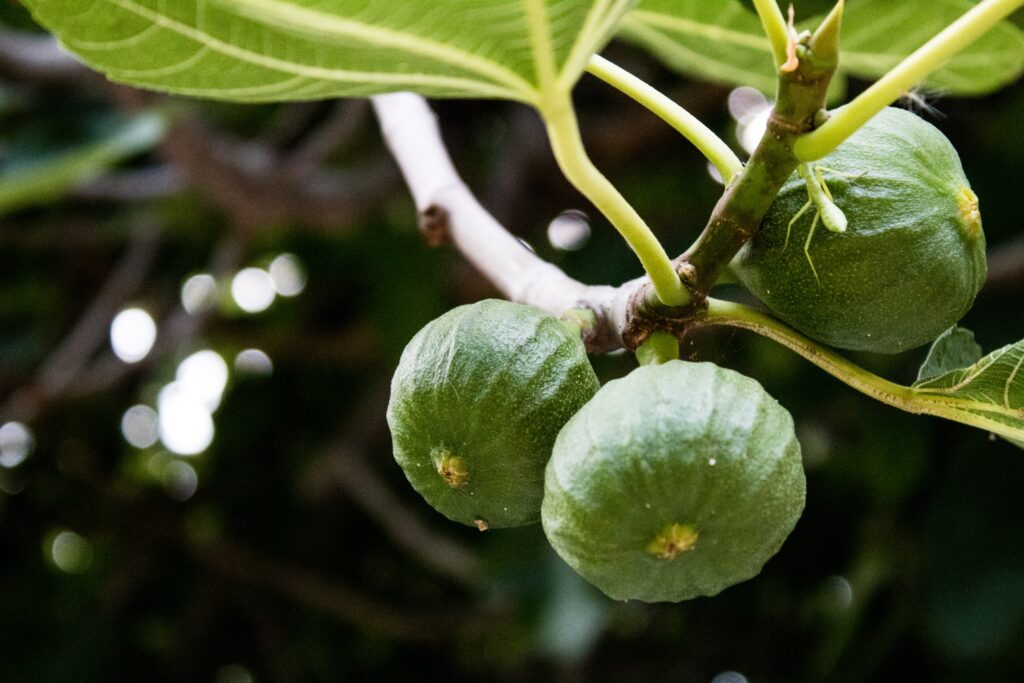
Photo by Martin Angelovon via Unsplash
September is the tensest month. Now large enough to cover shame, fig leaves shade branches dotted with hard green fruit, and the summer sun has lost its fire. I check long-term forecasts, watch YouTube videos, demand that my husband pull up the irises that might be cooling the soil around my precious fig trees’ roots. Should I swaddle them, the way Linus used his blanket to save Charlie Brown’s Christmas tree? Bit much. Instead, I rake away mulch like a madwoman, break off leaves near the top, then glare up at the sun, willing it to heat the trees.
They are sacred. Always have been. My little guys have to start over almost from scratch after every Midwestern winter; they will never provide the kind of canopy that shaded Siddartha Gautama long enough to transform him into the Buddha. His fig tree was the Bo, or Bodhi—Ficis religiosa, which can grow ninety feet tall and live for two thousand years and has leaves shaped like hearts. But there are more than eight hundred other species of figs. Surely the leaves Adam and Eve plucked to cover themselves were larger than hearts, more like my tree’s spread out, five-lobed leaves, which are, conveniently, bigger than a human hand.
If the first couple grabbed for fig leaves when they were naked, were they reaching toward the Tree of Knowledge that Eve had just raided? I would not be at all surprised if figs, rather than apples, contained God’s knowledge. They are at once male and female, and I trust androgyny. Also, figs are not fruits at all, but hundreds of flowers turned inward.
I am damned if I will let those blossoms rot, unripened, in autumn’s chill.
One video suggests dabbing Vaseline with a Q-tip on the “eye” at the bottom of each fig, thus sealing in the methane that will cause it to ripen. Somehow this feels too clinical to me; also, the guy showed a before and after, and I could see no difference. I do have resolutions for next spring, though: more nitrogen (the nursery will think I am building a bomb), more water, more thorough pruning, a ruthless pinch of the first growth’s tips. . . .
Are they worth all this exertion? Oh, yeah. Figs are extra, full of drama. It is said that Cleopatra ordered her suicide weapon, an Egyptian cobra, brought to her hidden in a basket of figs. Alexander the Great claimed that ten thousand of his soldiers sheltered under one fig tree. D.H. Lawrence compared an overripe, “bursten” fig to a prostitute “making a show of her secret,” but biologist Meg Lowman reveals the real secret, which I find extraordinary: Tiny fruit wasps penetrate wild figs, lay their eggs inside, then die. Mothers tend to be self-sacrificing that way. The eggs hatch, and the male and female offspring mate with one another in that moist sweet chamber, then chew an exit tunnel while enzymes dissolve their mom’s carcass.
At the end of Lowman’s piece, a horrified reader asks if this is true “for the figs that we grow and enjoy here in the U.S.”
“Be at ease,” another commenter replies. “Most of the cultivated figs grown commercially form fruit without the wasp pollinators, which could never be found in the numbers needed.”
My trees are commercial; I am almost disappointed not to participate in the alchemy by eating dissolved wasp corpses. But another commenter cheers me by noting that in several Mayan languages, the word for a fig tree, huche, means “book tree,” because the ancient Mayans beat its inner bark into paper, on which they inscribed their hieroglyphics.
I think of this when I set down my book, go outside, and walk across the yard to make my ritual check. Four figs, hanging soft and dark on the lowest branches, are ready this morning. I carry them inside reverently, cupped in both hands. Then I hold just one, its skin velvety and taut, near bursting. It weighs little, yet there is a heaviness to its bottom that Rubens would approve. If I pressed, the skin would yield; instead I bring the fig to my mouth and gently slide my teeth down, biting it in half so I can see the crimson interior. A creamy white outline, then hundreds of miniature flowers the color of sparkling rosé, patterned like lace. No hostile rind, thick peel, or hard stem need be discarded; you can pop the whole fig into your mouth and taste the light grittiness of all those blossoms, their syrupy, earthy sweetness.
Is it any wonder that the promised abundance includes not only milk and honey but vines and fig trees? Figs are a superfood, giving us copper, B6, potassium, magnesium, selenium, manganese, zinc, iron, calcium, and fiber. The tree’s milky, sticky-as-semen latex sap is rubbed on cuts and spooned to children in the Amazon to cure stomach parasites. But all of that is incidental to me. Given that three-fourths of the world’s fig species grow in tropical climes, I like to think our Chicago Hardy trees are some of the sturdiest representatives of that long and sacred history. Every fall, I fight and pray for the figs to ripen in time, and I curse when they do not, just as Jesus rather uncharacteristically cursed a barren fig tree that refused to yield fruit to him.
That tree was just outside Jerusalem. Its season had ended; Jesus could see that the earth was no longer sustaining him. Hungry and cranky, he made his next stop the Temple, where he overturned the tables of the moneylenders and yanked away the chairs of the dove-sellers.
When he next saw the fig tree, it had withered under his curse—and his own death had been put into motion.
Had the figs been ripe, could he have borne to leave?
Read more by Jeannette Cooperman here.
